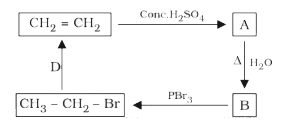Identify (A) to (D).

Video Solution
Text Solution
DU in A=(2×6+2)−62=4∘
(A) reacts with Grignard reagent to give 2 mol of CH4, showing there are two terminal acidic H atoms.
(A) on ozonolysis gives four C atoms dibasic acid, showing two C atoms are missing, which are lost as (HCOOH→CO2).
Proceed reverse to determine the structure of A:

|
Topper's Solved these Questions
- ALKYNESBOOK - CENGAGE CHEMISTRY ENGLISHCHAPTER - ALKYNESEXERCISE - Exercises (Linked Comprehension Type)
51 Videos
- ALKYNESBOOK - CENGAGE CHEMISTRY ENGLISHCHAPTER - ALKYNESEXERCISE - Exercises (Multiple Correct Answers Type)
25 Videos
- ALKYNESBOOK - CENGAGE CHEMISTRY ENGLISHCHAPTER - ALKYNESEXERCISE - Solved Examples
24 Videos
- ALKENES AND ALKADIENESBOOK - CENGAGE CHEMISTRY ENGLISHCHAPTER - ALKENES AND ALKADIENESEXERCISE - Single correct Answer
14 Videos
- APPENDIX - INORGANIC VOLUME 1BOOK - CENGAGE CHEMISTRY ENGLISHCHAPTER - APPENDIX - INORGANIC VOLUME 1EXERCISE - chapter-7 Single correct answer
1 Videos
Similar Questions

Identify D
View SolutionIdentify (B) and (D) in the following reaction:

View SolutionMagnesium on heating in air gives (A) and (B). On reaction with water (B) gives a colourless gas (C).(C) when passed through CuSO4 solution, gives a blue coloured solution (D). Identify (C)
and (D).
View SolutionIdentify A and D in the following sequence of reactions :

View SolutionIdentify (B),(c), and (D).
 .
.
View Solution
Identify A, B, C, D
View SolutionIdentify (A),(B),(C) and (D).
 .
.
View Solution
Identify A, B, C, D & E in given eukaryotic nucleus diagram :-

View SolutionIdentify the structures of (A) to (D).
 here A is pent-1,4-diene
here A is pent-1,4-diene
View SolutionIdentify A,B,C and D.
_E01_916_Q01.png)
View Solution
